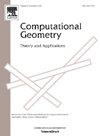Minimum-width double-slabs and widest empty slabs in high dimensions
IF 0.4
4区 计算机科学
Q4 MATHEMATICS
Computational Geometry-Theory and Applications
Pub Date : 2025-02-25
DOI:10.1016/j.comgeo.2025.102173
引用次数: 0
Abstract
A slab in d-dimensional space is the set of points enclosed by two parallel hyperplanes. We consider the problem of finding an optimal pair of parallel slabs, called a double-slab, that covers a given set P of n points in . We address two optimization problems in for any fixed dimension : the minimum-width double-slab problem, in which one wants to minimize the maximum width of the two slabs of the resulting double-slab, and the widest empty slab problem, in which one wants to maximize the gap between the two slabs. Our results include the first nontrivial exact algorithms that solve the former problem for and the latter problem for .
最小宽度的双层板和最宽的高尺寸空板
d维空间Rd中的平板是由两个平行超平面包围的点的集合。我们考虑寻找最优的平行平板对的问题,称为双平板,覆盖Rd中给定的n个点的集合P。对于任何固定维度d大于或等于3,我们在Rd中解决两个优化问题:最小宽度双平板问题,其中人们希望最小化所得到的双平板的两个平板的最大宽度,以及最宽的空平板问题,其中人们希望最大化两个平板之间的间隙。我们的结果包括解决d大于或等于3的前一个问题和d大于或等于4的后一个问题的第一个非平凡精确算法。
本文章由计算机程序翻译,如有差异,请以英文原文为准。
求助全文
约1分钟内获得全文
求助全文
来源期刊
CiteScore
1.60
自引率
16.70%
发文量
43
审稿时长
>12 weeks
期刊介绍:
Computational Geometry is a forum for research in theoretical and applied aspects of computational geometry. The journal publishes fundamental research in all areas of the subject, as well as disseminating information on the applications, techniques, and use of computational geometry. Computational Geometry publishes articles on the design and analysis of geometric algorithms. All aspects of computational geometry are covered, including the numerical, graph theoretical and combinatorial aspects. Also welcomed are computational geometry solutions to fundamental problems arising in computer graphics, pattern recognition, robotics, image processing, CAD-CAM, VLSI design and geographical information systems.
Computational Geometry features a special section containing open problems and concise reports on implementations of computational geometry tools.

 求助内容:
求助内容: 应助结果提醒方式:
应助结果提醒方式:


